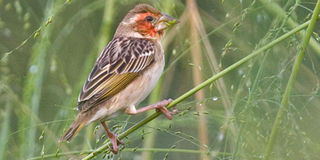State sprays 8m quelea birds destroying rice in Kirinyaga

The ravenous quelea bird. An estimated eight million quelea birds which had been wreaking havoc on rice farms at the giant Mwea Irrigation Scheme in Kirinyaga County have been killed. PHOTO | FILE | NATION MEDIA GROUP
What you need to know:
- A swam of two million birds can eat as much as 20 tons of grain in a single day.
- The birds usually invade the scheme from September when rice starts maturing.
- Mwea scheme produces 80 percent of the rice consumed in Kenya.
An estimated eight million quelea birds which had been wreaking havoc on rice farms at the giant Mwea Irrigation Scheme in Kirinyaga County have been killed.
The national government in conjunction with Governor Anne Waiguru's administration sprayed the birds after complaints from thousands of farmers.
According to Kirinyaga Deputy Governor Peter Ndambiri, the control of the voracious feeders comes after weeks of surveillance by the county’s Agriculture department.
“When farmers complained of the invasion of their farms by the birds, our officers embarked on monitoring the birds’ movement and locating their roosters. The birds have been sprayed for two days consecutively and farmers should now expect a bumper harvest," Mr Ndambiri added.
FARMERS HAPPY
The farmers congratulated the national and county governments for the intervention.
"Were it not for the intervention of the authorities, the birds would have wiped out our crop. We are now relieved following the control of the birds," said Mr Simon Njogu.
Quelea are some of the most destructive birds since one can eat up to 10 grams of grain every day.
A swam of two million birds can eat as much as 20 tons of grain in a single day and therefore become a threat to more than 20,000 acres of rice in the Mwea scheme, according to agricultural experts.
MIGRATORY BIRDS
The birds usually invade the scheme from September when rice starts maturing.
The birds which belong to the weaver family are found in the tropics.
They are classified as migratory birds due to their ability to move long distances at certain seasons or under certain circumstances looking for food and roosting grounds.
They flock in large populations and are highly mobile and have few natural predators and breed extremely fast.
The most common way of controlling the pests is by large-scale spraying of their roosters.
Mwea scheme produces 80 percent of the rice consumed in Kenya and hence the urgent government intervention.





